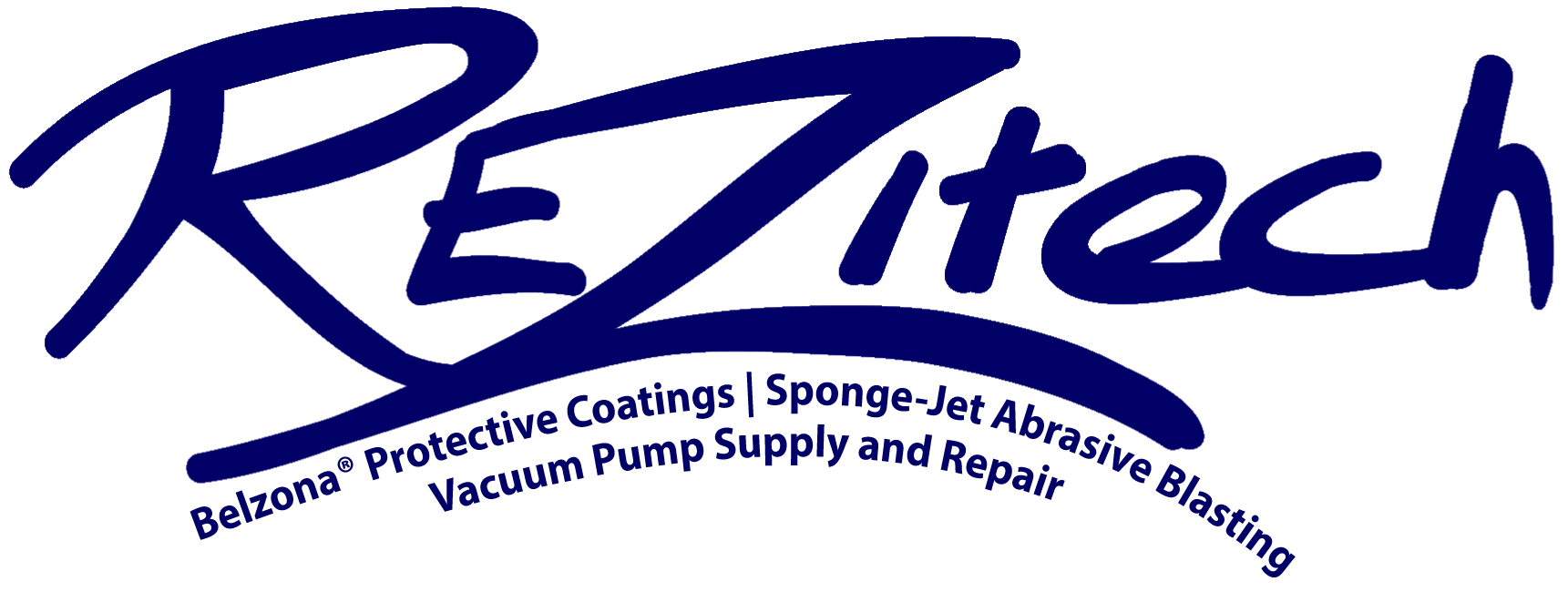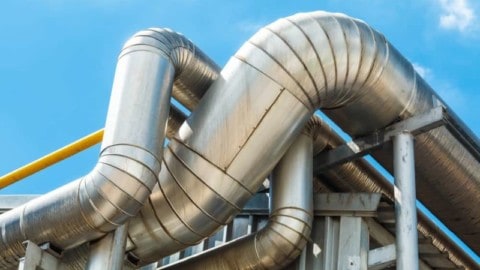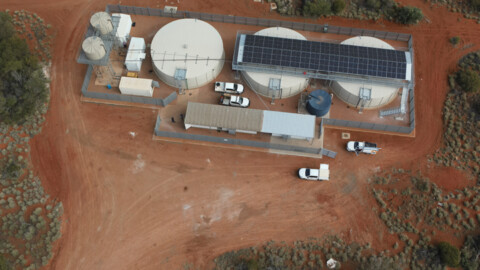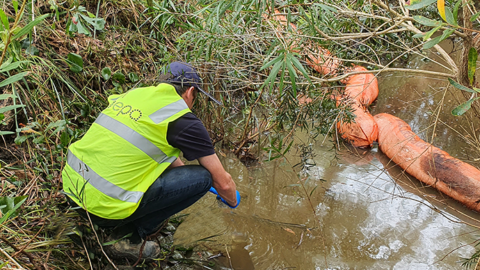By Heinz P. Bloch, PE, Process Machinery Consulting
Equipment reliability at a major oil refinery in Western Australia ranks very high among the prominent users of plant-wide oil mist. Worldwide, there are now an estimated 160,000 process pumps and 50,000 electric motors that are lubricated with oil mist as of 2019. Well over 3,000 plant-wide oil mist systems are presently operating in close to 100 countries around the world; these range from the wind-blown Caribbean to the dry heat of Saudi Arabia, from humid Singapore and semi-tropical Venezuela to the wintery cold of Northwestern Canada.
A plant-wide system is schematically shown in Figure 1.
Figure 1: Schematic illustration of a plant-wide oil mist system.
As early as 1965, oil mist lubrication proved by far the most successful lube application method on two 1,250hp vertical electric motors at a large refinery(1). A recent book(2) includes highly informative updates on this mature technology.
Oil mist has been used by a bearing manufacturer since 1937 and by a textile machinery maker since the mid-1950s. By the early 1960s, oil mist had found its way into the process industries.
Why oil mist is mature technology
This gets back to an important point: oil mist lubrication should always be mentioned together with the additionally relevant topic of interest, oil mist preservation(3).
As is well known, oil mist fully preserves standby equipment and eliminates the mistakes often made with grease lubrication.
The resulting reliability increase deserves to be reflected in the cost justification, as should failure avoidance and the ensuing reduction in pump related fires.
After oil and air are brought together at or near an ideal mixing temperature of 38°C (about 100°F) at a pressure of ~20 inches (~500mm) of H2O, the oil mist moves from this higher pressure to the much lower pressure (5-10mm of H2O) that typically exists in a bearing housing.
Once generated, oil mist will move in an unheated, uninsulated header and it will do so whether the external environment is at minus 45°C in Canada or plus 45°C somewhere in North Africa or the Middle East.
Visualise oil mist to travel and behave like cigarette smoke. Today, every experienced user plant applies oil mist to both its pump and electric motor bearings(4).
Numerous papers and articles have documented oil mist preservation; an outdoor storage yard is shown in Figure 2. Finally, converting from grease to oil mist lubrication can be done with equipment running and is especially straightforward with electric motors(5).

Figure 2: Crated equipment in an outdoors storage yard.
Relating oil mist experiences
A full 20 years ago, the CEO and majority shareholder of a prominent lubrication provider reported that plant-wide oil mist lubrication had been applied in over 100 refineries and chemical plants in dozens of different countries.
Although we are still not permitted to publish the names and locations of plants that supplied relevant data, we can share the benefits calculated by some of these oil mist users.
It should be noted that these data include numbers one can use in calculating cost justification and payback. Moreover, satisfied users included major multinational companies, as well as small facilities.
The investment made by these plants generated attractive returns and short payback periods based on improved equipment reliability and reduced maintenance cost.
The known areas of improvement with pure oil mist lubrication include:
1. Reduced pump and electric motor bearing failures:
- 80 to 90 per cent reduction in pump bearing failures is typical
- Electric motor bearing failures are often lowered by over 90 per cent
- Competent oil mist suppliers can provide data on:
a. Bearing failures at a major refinery in Thailand
b. A California refinery sharing its electric motor failure history
c. Bearing failure histories at a major olefins plant
2. Reduced number of mechanical seal failure events
- Reduction of seal failures is in the range of 30 to 50 per cent
- One user reported that the average mechanical seal life doubled to eight years
- Examples included:
a. Bearing and seal experience of an oil mist user in California
b. Seal life comparison from an offshore facility
3. Reduced failures rates of specialty equipment:
- Oil mist application has shown excellent results in a variety of other equipment applications
- Rotary lobe blowers, chemical mixers and cooling tower fan gearboxes are examples of more specialised applications with big payouts
- Examples include:
a. Polymer processing equipment failure history
b. Applicable experience with rotary blowers
c. Highly favorable refinery cooling tower gearbox history
4. Results expressed as mean time between repairs/failures (MTBR/MTBF), significant improvement for pumps, drivers and other equipment:
- One user reports improvement from three years before oil mist to nine years after oil mist
- Another user went from four years before oil mist to almost eight years after oil mist was introduced
- Detailed examples are available for:
a. A refinery in a Pacific Rim country that published seal life comparisons and highlighted how bearing issues lead to seal failures
b. Highly favorable pump MTBR experience
c. Similar favorable small steam turbine MTBR experience
5. Disclosure of pump maintenance costs, showing significant reductions. Percentages are given; for example:
- One user reports a 40 per cent reduction in all work orders for pump maintenance
- Others reported pump repair costs reduced by 60 to 80 per cent. These included:
a. An asphalt plant in the United States
b. Experiences at several refineries
c. Dollar cost reduction numbers provided by one refinery
6. Operations manpower to carry out lubrication tasks was reduced. Examples include:
- A user reporting a 47 per cent reduction in hours needed to complete lubrication related tasks
- User feedback from a Pacific Rim country supported the data
7. Lubricant consumption was reduced:
- A 40 per cent typical reduction due to more efficient application of lubricant
- One user reduced consumption by 70 per cent by applying recommended oil recovery steps
- A comparison of oil usage in several affiliated Pacific refineries is available
8. Reduced energy consumption is a fact:
a. At a minimum, a one to two per cent lower energy use was demonstrated in several controlled tests. Some tests by a major bearing manufacturer demonstrated a three and six tenths per cent efficiency gain
b. A South American energy consumption study has been published
9. Eliminated lost production incidents:
a. A specialty polymer producer estimated a seven to eight per cent run time improvement
b. A refiner eliminated costs from lost production incidents on a crude oil unit
The overall economic results from five refining applications have been published. The results are:
A. Western United States Refinery:
a. Applied oil mist to crude unit, fluid catalytic cracking unit (FCCUs) and steam boiler area in 1999
b. Experienced sharp reduction in pump maintenance costs
c. Eliminated lost production incidents on crude unit
d. Discounted cash flow (DCF) returns exceed 200 per cent
e. Payback achieved in less than one year
B. United States Southern Great Plains State Asphalt Plant:
a. One system serving entire plant was installed in 1997
b. Pump repair costs dropped 72 per cent
c. DCF return of 150 per cent
d. Payback in less than one year
C. Overseas Refinery:
a. Installed systems throughout one plant in mid-1990s
b. Compared performance with sister plant without oil mist
c. Results include doubling of MTBR for pumps and seals, cutting operating manpower in half, and reducing lubricant consumption
d. Estimated DCF return for converting the other refinery to oil mist is 54 per cent
e. Estimated payback is only 1.9 years
D. Mid-Coast Refinery:
a. Two systems installed in 1996 in crude processing units
b. Pump bearing repair costs dropped 88 per cent
c. DCF return of 70 per cent based only on lower repair costs
d. Payback was achieved in 1.5 years
E. Southern United States Refinery:
a. Three systems installed in 1989
b. Pump repair costs reduced by 65 to 70 per cent
c. DCF returns of 75 per cent achieved, based only on pump repair savings
d. Payback in 1.5 years
Similarly, the overall economic results for three petrochemical applications were made available in 1998. They showed the following results:
A. Specialty Polymer Plant in a US Western State:
a. Failure rate on rotating equipment was about every six months before oil mist
b. Failure rate dropped 98 percent after mist applied
c. Plant availability to manufacture polymer increased five to seven per cent
d. DCF return without including increased production exceeded 400 per cent
e. Payback was achieved in less than six months
B. Commodity Polymer Plant in US Mid-South Region:
a. High rate of rotary lobe blower failures prompted oil mist investment
b. Blower maintenance costs reduced by 90 per cent within two years
c. Resulting DCF return of 45 per cent and a payback period of two years
C. Central US Gulf Coast Olefins Plant:
a. Compared pump failures between a plant built in early 1980s with oil mist versus one built ten years earlier using conventional lubrication
b. Pump bearing failures were 90 per cent lower in oil mist lubricated plant
c. DCF return based only on lower bearing failures is 75 per cent
d. Incremental cost of oil mist implementation yielded payback in 1.5 years
In early 2005, a Saudi Arabian refinery reported accurate tracking of 1,400 process pumps lubricated by pure oil mist.
In the previous year, there were no bearing failures in these pumps. The results coincided with those of other companies in the two decades before 2005: oil mist is a safe, environmentally friendly and technically sound lubrication method.
Its reliability is unsurpassed and the resulting maintenance cost reductions and downtime avoidance savings have, for decades, been enjoyed by best in class performers in the United States and overseas.
Late updates confirm earlier findings
Two separate updates on oil mist technology, occurring between November 2018 and March 2019 are worth mentioning.
The first one came from a well-respected reliability engineer who was mystified when a new project did not include oil mist lubrication for a new process unit at his plant location.
The unit was expected to be highly reliable and had been approved by the corporation’s board of directors based on several claims, among them, the claim of having been designed to minimise maintenance.
The senior reliability professional at the plant receiving the project wrote:
“The issue of optimised lubrication comes up whenever our world scale oil refinery engages in plans for expanding throughput in process units or becomes the licensor for some of its process technologies.
“As a matter of custom and experience, the choice of properly designed and installed oil mist is not an issue with this refinery.
“The latest unit commissioned at our refinery, circa 2001, has had all its pumps running on oil mist for 14 years and has not had a pump out for bearing maintenance.
“This is, so far, an infinite MTBR (meantime between repairs). The process is relatively clean gasoline products and our pumps were properly sized for the various services.
“Sister units using oil mist have had a similarly long MTBR. Operations teams and reliability groups believe in the results achieved with oil mist, along with proper sizing and proper installation of process pumps.
“The statistical evidence is very supportive of the choices made since the early 1970s when oil mist was first tried in this facility.
“Regrettably, we still run into disagreement with an obviously contrarian corporate philosophy. We know that this disagreement originates with a perpetually unconvinced or probably not convincible subject matter expert (SME) far from our shores.
“This SME simply does not see the benefits of oil mist that we have experienced and have understood for years. Our refinery is completely sold on oil mist and firmly advocates its use.”
Another update reads as follows:
“Our pump MTBR right now is somewhere between 114 and 120 months, depending on a lot of things, but we consider these numbers close enough.
“In any event, we still have not had a lubrication-related bearing failure since 1999 that’s worth mentioning.
“Note that as of 2018 we have ACHE (air-cooled heat exchanger) fan bearings that have not been touched since the fans were installed in 2004.
“Moreover, the same impeccable results were obtained with the pillow block bearings on the FD (forced draft) and ID (induced draft) fans at our refinery, which, as you know, is the largest on this continent.”
The above reflects solid professionalism. Indeed, most reliability professionals are motivated and determined to ‘speak truth to power’, as the saying goes.
These fact-oriented professionals continue to bring solid information to their project leaders and managers as they strive towards becoming best in class. The SME mentioned above is an outlier and his motivations are unknown.
Fewest shutdowns on record
According to primary providers of plant-wide oil mist systems, only three shutdown incidents are known to have occurred on oil mist systems since 1982. An estimated 3,400 plant-wide systems have been in successful service since that time.
The first recorded systems interruption involving a modern plant-wide oil mist system occurred at a US Gulf Coast facility around 1982.
At that time, a thorough analysis traced the failure to pipe shavings in the five-gallon capacity misting chamber reservoir.
Ferrous debris became attached to a magnetic level switch, preventing it from activating a solenoid.
Uninhibited solenoid movement would have allowed lubricant from a bulk oil holding tank to replenish the much smaller chamber reservoir.
When the small reservoir was depleted, none of the connected equipment received oil mist. The bearings ran dry but did so without incident or bearing failure.
As an aside, the question on how long one can run standard bearings without lubrication was answered in the early to mid-1960s.
It was then known that bearings coated with oil in horizontally installed shaft systems can operate for about eight hours after discontinuing oil mist flow.
Test results were reported and explained by Dow Chemical’s Allen Clapp, and Fred Wilcox(6). Their test-based findings were again corroborated in full-fledged academic research conducted by Abdus Shamim in pursuit of a doctorate at Texas A&M University(7).
The observations by Clapp and Wilcox indicated that a small pool of oil will collect in the five to seven o’clock segment of the contoured raceway in a bearing’s outer ring.
Oil mist lubricated pumps can safely stay in service for approximately eight hours before this small pool of oil is depleted.
Given that there is ample supervisory instrumentation to indicate deviations, no modern oil mist system has ever encountered unavailability in excess of eight hours.
The second unavailability event developed at an oil refinery in Enid, Oklahoma, where a single oil mist console was serving two adjacent process units.
When the process unit where the oil mist generator (OMG) was located had to be shut down in preparation for scheduled maintenance and repair downtime, the OMG valve was inadvertently shut.
A day or so later, the adjoining process unit experienced a pump failure. It was immediately realised that there had been no oil mist supplied for at least 24 hours.
The oil mist supply was then quickly restored, and no other bearing failures were experienced on any of the connected pumps.
The cause of the failure was clearly human error; it could have been averted with a simple advisory note posted at the appropriate switch or valve.
A third incident report relates to a Texas Gulf Coast oil refinery where the owner-purchaser had opted not to include an automatic fill option on the OMG console.
A manual reservoir refill line connected a bulk storage tank to the small, 10L oil reservoir located inside the main oil mist console.
An operator decided to crack open the needle valve in the refill line, expecting it to slowly maintain the oil level in the small reservoir.
After a while, the entire piping distribution system had filled with liquid oil and the liquid oil had, in fact, displaced the atomised oil mist.
About 12 pump bearing housings and their respective motor driver bearings were affected. A lot of oil was wasted, but there were no equipment failures in this incident.
It’s very difficult to remove the human element from a plant. All the checklists, procedures, signal lights, bells, whistles, tablets and laptops are of no benefit if a person decides not to pay attention.
But here is the good news: modern oil mist systems are provided with suitable supervisory instrumentation. As a result, there are no known reports of any system being disrupted for more than two hours in the years from 2000 to 2018.
In 1998, overall reliability and availability were calculated by various observers as 99.99962 per cent (lowest) and are currently thought to have reached 99.999997 per cent (highest).
The various availabilities recorded and reported for plant-wide oil mist systems have never been approached by any other lubrication method.
What can shut down an oil mist system?
Considering the aforementioned three incidents, one has to wonder what else could cause an oil mist unit or system to shut down.
Well, running a forklift into the two-inch oil mist header would shut the system down. It’s a rather remote possibility, since such an incident has never been reported on any of the estimated 3,400 plant-wide oil mist systems now in service all over the world.
But, if it did happen, it would take less than eight hours to repair a header. Weld repairs could be done on the damaged header and filling the header with nitrogen would not be required while doing the repair.
Since very little can shut down an oil mist system, the most profitable and reliable plants have found that installing backup systems is not cost justified.
Nevertheless, some plants have occasionally asked oil mist suppliers to propose and provide 100 per cent redundancy. In those facilities, a backup or auxiliary oil mist system can be placed in operation on a moment’s notice.
Complete switchover from the main unit to a full backup takes 30 to 60 seconds. The switchover procedure calls for a one-quarter turn of the handle of a ball valve.
A two or three sentence procedure sheet is posted on the inside of the oil mist cabinet door. The sheet explains what to do in the highly unlikely event of such switchovers ever becoming necessary.
About the author
Heinz P. Bloch resides in Montgomery, Texas. His professional career commenced in 1962 and included long-term assignments as Exxon Chemical’s Regional Machinery Specialist for the United States. He has authored or co-written over 750 publications, among them 21 comprehensive books on practical machinery management, failure analysis, failure avoidance, compressors, steam turbines, pumps, oil mist lubrication and optimised lubrication for industry. Mr Bloch holds B.S. and M.S. degrees (cum laude) in Mechanical Engineering from the Newark College of Engineering and is a member of the college’s “NCE 100’s Anniversary Top 10.” He is an ASME Life Fellow and was awarded life-time registration as a Professional Engineer in New Jersey.
References
(1) Miannay, Charles R, ‘Improve Bearing Life’, Hydrocarbon Processing, May 1974
(2) Bloch, Heinz P, F.K. Geitner, and D.C. Ehlert, ‘Optimized Equipment Lubrication, Oil Mist Technology, and Storage Preservation’, (Dec 2019), Reliabilityweb, Ft. Myers, FL
(3) ibid
(4) Bloch, Heinz P, ‘Dry Sump Oil Mist Lubrication for Electric Motors’, Hydrocarbon Processing, March 1977
(5) Bloch, Heinz P, Improving Machinery Reliability, 3rd Ed. 1998, Gulf Publishing Company, Houston, TX
(6) Clapp, Allen M and Wilcox, Fred B, “Plant Lubrication”, Proceedings of the Seventh Texas A&M University International Turbomachinery Symposium, 1978
(7) Bloch, Heinz P and Shamim, Abdus, Oil Mist Lubrication: Practical Applications, Lilburn: Fairmont Press, 1998




















